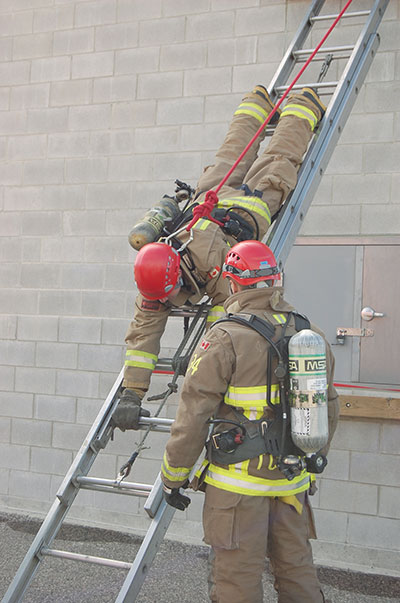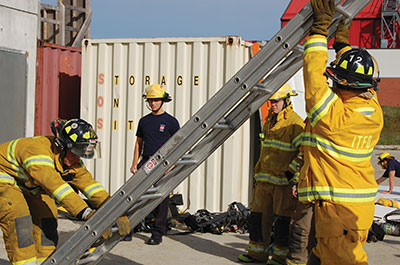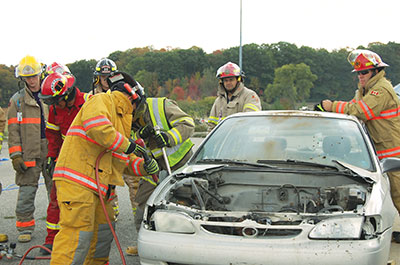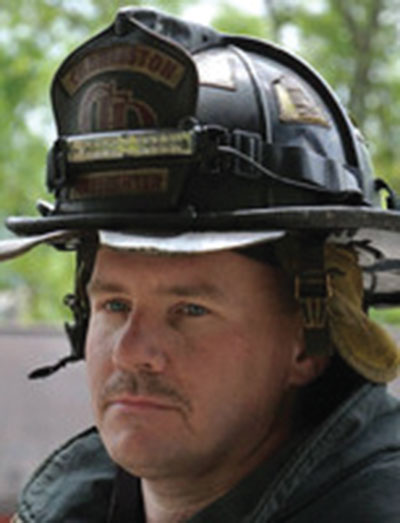
Features
Hot topics
Incident reports
Assessing your skills
You are responding to a fire with a confirmed entrapment: What do you do to prepare for the challenges ahead?
June 21, 2013
By Ryan Pennington
You are responding to a fire with a confirmed entrapment: What do you do to prepare for the challenges ahead? Every firefighter who pulls on a pair of boots probably has a different answer.
 |
|
| Doing a personal skills assessment will give firefighters an idea of how much they need to refresh or re-learn a certain task. photos by Olivia D’Orazio
|
From Day 1, a career as a firefighter forces us to evaluate our skills. As we age, we gain years of experience, and in many cases we advance up the chain of command, but it is critical that firefighters of all ranks rate their performance on the fire ground and their skills.
Have you evaluated how skilled you are as a firefighter? Evaluation isn’t such a bad term; you are simply analyzing your performance in training, on calls and around the fire hall, and making sure that you keep focused and are always prepared. Let’s take a look at some helpful tips from the jumpseat view – my view – to keep you jumpseat ready as you progress through your career.
Evaluating your performance
Many fire departments conduct evaluations of their firefighters, based on a set of standards. These evaluations can be great tools to help firefighters identify strengths and recognize weaknesses that may need attention. One potential problem with these third-party evaluations is that the superior officer may not be able to provide a completely honest evaluation while remaining politically correct. Often, supervisors cannot drop the hammer.
Firefighters can combat this problem by performing honest self-assessments. Our skills are perishable; if we don’t use them, we lose them.
Doing a personal skills assessment will give you an idea of how much you need to refresh or re-learn a certain task. Let’s say that at your last drill, you found it difficult to throw a 24-foot ladder by yourself and, therefore, it took you longer to complete the task. While an officer who recognized that you needed to improve that skill could point out your deficiencies to you, if you are evaluating yourself, you can be brutally honest – Ryan, that is unacceptable! It’s time to practice with the 24-footer until you can do it faster, safer and more efficiently.
Honesty can be the levelling factor when performing a self-evaluation. Constants such as time of day, weather, age and fitness levels should be considered when checking your own skill levels. Maybe it took longer to throw the 24-footer because it was 30 C outside. But while the temperature needs to be considered, only a small allowance should be permitted for those types of circumstances, since we fight fires in all weather conditions and should be prepared to do so.
Keep an annual training calendar
When was the last time you practised your skills? If you haven’t touched a Halligan in months, how can you expect to use it proficiently?
 |
|
| While an officer who recognizes that a firefighter needs to improve a skill could point out that deficiency to him, if that firefighter is evaluating himself, he can be brutally honest.
|
Before you rant about how it isn’t your job to log your training – actually, it is. Many of us work multiple jobs and have kids, dogs and hobbies that take us away from our departments consistently, causing us to miss out on different drills and skills. While it is the training officer’s duty to establish a schedule and ensure that we all go through each skill, it should be your responsibility to identify any missed rotations or skills that need to be refreshed. Many departments have a lot of members and some of us can be accidentally overlooked.
By keeping track of what types of training you have participated in, the location of that training, and any needed improvements to those skills, you can better identify areas in which you need improvement. This training log will serve you in other ways, as well. If your training officer calls on you to help establish a training calendar, you can reference your log to help identify areas for improvement. In the days of electronic everything, it doesn’t take much time or effort to make a note on your calendar when you take a class, participate in a drill, introduce a new skill or practice an old one.
An example of a training log:
- May 1, 2013: Swift-water technician refresher training
- Location: New River
- Need: Boat operation is an area in which I could use more experience and time to train
Another example:
- Jan. 1, 2013: Structure fire
- Location: 123 Main St.
- Need: The Chief assigned us to vertical ventilation and I struggled with saw operations
If you write down your needs, your successes and the areas that could use more practice, you will have a better reference when choosing classes and drills that you should not miss.
How practical is recording your training? That depends on how often you log the information, how detailed you are and whether you are ready for an honest evaluation of your skills. Firefighters all want to think that they can climb 100 flights of stairs and make the grab, but reality has a way of sneaking up on us if we haven’t given the right amount of attention to our skills.
Preparing to lead
Do you have aspirations to become a chief officer? If you are like me, and I bet you are, you want to be a fire-service leader. The process starts the very first day you walk into the fire hall. Using yourself as an experiment will allow you to start preparing to lead. Constantly evaluating, logging and revisiting needed improvements will start you on the road to leadership. Who better to learn from than yourself? You can be brutally honest – no political correctness needed.
Example:
- June 1 – Auto accident: Ryan had trouble stabilizing the vehicle
- Remediation: Schedule a drill for C-shift to review the use of cribbing, jacks and the co-ordination of efforts.

|
|
| By keeping track of what types of training you have participated in, the location of that training, and any needed improvements to those skills, you can better identify areas in which you need improvement.
|
Being a street-level firefighter, or jumpseat rider, can give you the perspective of a follower and help you understand how your peers would react to your leadership. How would you receive the request and how can you make sure that firefighter Ryan received the refresher training that he needed? How many times have you said, “The chiefs have forgotten where they came from”? If you learn to lead while you are still following, you will have a great sense of how and why to lead, a view that should never be forgotten.
We all would like to think that we could walk up the stairs in full gear, force a door, make the grab and smile when the mayor pins a medal on our chest. But many of us don’t experience the numbers of fires or, in some cases, the amount of training that it takes to keep up with all that is asked of us. From hazmat to EMS and structural fire fighting, our skills will diminish if we do not give them the attention they need. Taking the time to evaluate your performance, keeping a training log and learning from your time in the jumpseat will make you a well-rounded firefighter and, eventually, an officer, or perhaps a chief. Being fair and honest, and making sure that we can do what is asked of us at all times, will ensure that we all go home safely!

|
|
Ryan Pennington is a firefighter/paramedic for the Charleston Fire Department in Charleston, W. Va. He is assigned to Station 8 and is part of the West Virginia Task Force 1 USAR team. Ryan has more than 15 years of combined fire, rescue and EMS experience. He started with a volunteer department and continued through EMS, spending five years as a critical-care paramedic. Ryan transferred to the career fire service in 2003 and has worked for the City of Charleston since 2007. He is a West Virginia State Instructor 2, a hazmat technician, and a certified Fire Officer 2. He teaches EMS and firefighter safety across North America. Contact him at jumpseatviews@icloud.com and follow him on Twitter @Jumpseatviews
Print this page